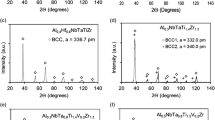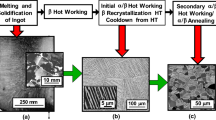Abstract
Near-α titanium alloys are used at higher temperatures than any other class of titanium alloys. As a consequence of thermal exposure, these components may develop locally elevated oxygen concentrations at the exposed surface which can negatively impact ductility and resistance to fatigue crack initiation. In this work, monotonic and fatigue fracture mechanisms of Ti–6Al–2Sn–4Zr–2Mo–0.1Si samples exposed to laboratory air at 650 °C for 420 h were identified by means of a combination of quantitative tilt fractography, metallographic sectioning, and electron backscatter diffraction. These mechanisms were compared and contrasted with those operative during similar tests performed on material is the as-received condition with uniform oxygen content. While faceted fracture was not observed during quasi-static loading of virgin material, locally elevated concentrations of oxygen near the surfaces of exposed samples were shown to change the fracture mode from ductile, microvoid coalescence to brittle facet formation and grain boundary separation at stresses below the macroscopic yield point. Similar features and an increased propensity for facet formation were observed during cyclic loading of exposed samples. The effects of this time-dependent degradation on monotonic and cyclic properties were discussed in the context of the effect of oxygen on crack initiation and propagation mechanisms.





















Similar content being viewed by others
References
Srinadh KVS, Singh V (2004) Bull Mater Sci 27:347
Welsch G, Bunk W (1982) Metall Trans A 13:889
Williams JC, Sommer AW, Tung PP (1972) Metall Trans 3:2979
Shamblen CE, Redden TK (1968) In: Jaffee RI, Promisel NE (eds) The science, technology and application of titanium. Pergamon Press, New York, p 199
Shenoy RN, Unnam J, Clark RK (1986) Oxid Met 26:105
Mahoney MW, Paton NE (1978) Metall Trans A 9:1497
Bache MR, Evans WJ, Davies HM (1997) J Mater Sci 32:3435. doi:10.1023/A:1018624801310
Sinha V, Mills MJ, Williams JC (2006) Metall Trans 37:2015
Pilchak AL, Williams REA, Williams JC (2010) Metall Trans 41:106
Bantounas I, Dye D, Lindley TC (2009) Acta Mater 57:3584
Pilchak AL, Williams JC (2010) Metall Mater Trans A 41:22
Ward-Close CM, Beevers CJ (1980) Metall Mater Trans A 11:1007
Sarrazin-Baudoux C, Lesterlin S, Petit J (1996) Titanium 95(2):1895
Shiveley AR, Shade PA, Pilchak AL, Tiley JS, Kerns R (2011) J Microsc 244:181
Pilchak AL, Shiveley AR, Tiley JS, Ballard DL (2011) J Microsc 244:38
Themelis G, Chikwembani S, Weerman J (1990) Mater Charact 24:27
Slavik DC, Wert JA, Gangloff RP (1993) J Mater Res 8:2482
Sinha V, Mills MJ, Williams JC (2007) J Mater Sci 42:8334. doi:10.1007/s10853-006-0252-z
McReynolds KS, Tamirisakandala S (2011) Metall Mater Trans A 42:1732
Brockman RA, Pilchak AL, Porter WJ, John R (2011) Scripta Materialia 65:513
Parthasarathy TA, Porter WJ, Boone S, John R, Martin PL (2011) Scripta Materialia 65:420
Beachem CD, Pelloux RMN (1965) Fracture toughness testing and its applications. ASTM STP 381, p 210
Mahajan Y, Margolin H (1982) Met Trans A 13:257
Jago G, Bechet J, Bathis C (1996) Titanium 95(2):1203
Pilchak AL, Williams JC (2011) Metall Mater Trans A 42:1000
Chesnutt JC, Spurling RA (1977) Met Trans A 8:216
Van Stone RH, Cox TB (1976) Fractography—microscopic cracking processes. ASTM STP 600, p 5
Van Stone RH, Low JR Jr, Shannon JL Jr (1978) Met Trans A 9:539
Chesnutt JC, Williams JC (1977) Met Trans A 8A:514
Ro YJ, Agnew SR, Gangloff RP (2005) Scripta Materialia 52:531
Bowen AW (1975) Acta Metall 23:1401
Salem AA, Glavicic MG, Semiatin SL (2008) Mater Sci Eng A 494:350
Williams JC (1973) In: Jaffee RI, Burte HM (eds) Titanium science and technology. Plenum Press, New York, p 1454
Lütjering G, Williams JC (2003) Titanium. Springer, New York
Zeng L, Bieler TR (2005) Mater Sci Eng A 392:403
Pilchak AL, Williams JC (2009) Metall Mater Trans A 40:2603
Larson F, Zarkades A (1974) Metals and Ceramics Information Center Report 20:1
Davidson DL, Eylon D (1980) Metall Mater Trans A 11:837
Wagner L, Gregory JK, Gysler A, Lütjering G (1986) In: Ritchie RO, Lankford J (eds) Small fatigue cracks, Proceedings of the second engineering foundation international conference/workshop, Metallurgical Society, Santa Barbara, CA, pp 117–127
Pilchak AL, Bhattacharjee A, Rosenberger AH, Williams JC (2009) Int J Fatigue 31:989
Evans WJ, Jones JP, Whitaker MT (2005) Int J Fatigue 27:1244
Sarrazin C, Chiron R, Lesterlin S, Petit J (1994) Fatigue Fract Eng Mater Struct 17:1383
Larsen JM (1987) The effects of slip character and crack closure on the growth of small fatigue cracks in titanium-aluminum alloys, PhD Dissertation, Carnegie Mellon University (approved for public release in 1990)
Liu Z, Welsch G (1988) Metal Trans A 19:527
Ravichandran KS (1997) Metall Mater Trans A 28:149
Ravichandran KS, Larsen JM (1997) Metall Mater Trans A 28:157
Suresh S (1998) Fatigue of materials, 2nd edn. Cambridge University Press, New York, pp 541–568
Santus C, Taylor D (2009) Int J Fatigue 31:1356
Sinha V, Mills MJ, Williams JC (2004) Metall Mater Trans A 35:3141
Jha SK, Caton MJ, Larsen JM (2007) Mater Sci Eng A 468–470:23
Acknowledgements
This work was performed as part of the in-house research activities of the Air Force Research Laboratory, Materials and Manufacturing Directorate, AFRL/RXLM, Wright Patterson Air Force Base, OH. The financial support of the Air Force Office of Scientific Research through Task No. 09RX24COR, Dr. David Stargel, Program Manager, is gratefully acknowledged. Two of the authors were partially supported under onsite Air Force contracts FA8650-07-D-5800 (ALP), Dr. Ali Sayir, Program Manager, and FA8650-09- D-5223 (WJP) during the time this work was completed.
Author information
Authors and Affiliations
Corresponding author
Rights and permissions
About this article
Cite this article
Pilchak, A.L., Porter, W.J. & John, R. Room temperature fracture processes of a near-α titanium alloy following elevated temperature exposure. J Mater Sci 47, 7235–7253 (2012). https://doi.org/10.1007/s10853-012-6673-y
Received:
Accepted:
Published:
Issue Date:
DOI: https://doi.org/10.1007/s10853-012-6673-y




